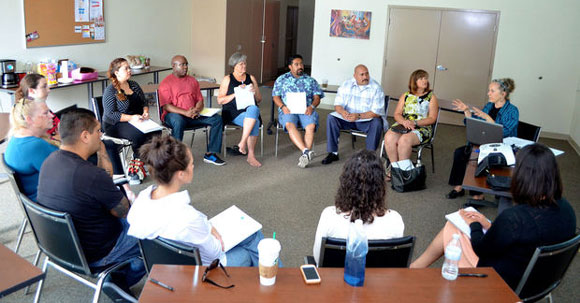Restorative Justice Takes Focus Off Punishment
Written by Kyle Harding, Santamaria.com

On Saturday many gathered for a conflict solutions class to focus on restorative justice.
Many criminals first enter the justice system as children, and advocates of reform say that changing the way juvenile crimes are punished can help keep them out of trouble later on.
“It’s not working the way we have it set up right now,” Kimberly Rosa said, referring to what she calls the “retributive justice” system which focuses on punishing a crime.
Rosa, co-executive director of Conflict Solutions Center, recently led a group of 11 community members through a two-Saturday course to become “restorative justice” facilitators.
Restorative justice brings together crime victims and offenders to address the damage done in a crime, and facilitators help negotiate what should be done about it.
Though the concept can be applied to a wide variety of crimes and offenders, Rosa said that in Santa Barbara County it is focused on juvenile offenders and that the crimes tend to be either property crimes or minor batteries.
Offenders are referred into the system from either the Probation Department or the District Attorney’s Office.
Santa Barbara County Deputy Chief Probation Officer Steve DeLira, who heads up juvenile probation, said that youth offenders can benefit from hearing about how their actions have affected others.
“Juveniles are impulsive,” he said. “Restorative justice addresses that cognitive part and gets them to think.”
DeLira said that having offenders attend victim panels can give them perspective.
“I think that is what helps these young people stay away from the juvenile justice system,” he said.
Staying out of the system when they are minors can keep them out of trouble as they grow into adulthood as well, Rosa said.
“If they get locked up, they’re learning how to be better criminals,” she said to her class of facilitators-in-training.
Rosa said there doesn’t seem to be an openness to applying restorative justice to young adult offenders in the county yet.
DeLira said that 30 juveniles were referred to restorative justice by the Probation Department in 2103 and successfully completed it, and 26 of them have stayed out of trouble for at least a year, an 86 percent success rate.
However, probation as a whole is successful in the county, with a success rate of nearly 85 percent for a total of 327 cases in the same year.
“Both programs do well,” DeLira said.
In order for a youth offender to be accepted into the restorative justice program, the case must have a specific victim.
“A petty theft of a mom-and-pop store would be more appropriate than, say, Target,” DeLira said.
Drug possession, with no specific victim, is also out. So are “serious, violent felonies,” DeLira said.
In order to enter the program, the victim must consent.
“My experience has been that the vast majority of victims are interested in participating,” Rosa said. “They realize that this could really help that kid so he doesn’t do it again.”
The offenders must also be invested in the process, Rosa said.
“The resistance to recidivism must come from within,” she said.
Rosa said that most outcomes do not involve an exchange of money. Offenders may end up repairing damage caused by vandalism, making presentations to classes or tutoring younger kids.
“We do see a lot of relationships rebuilt,” said Esther Cortez, a restorative justice coordinator for Conflict Solutions Center.
